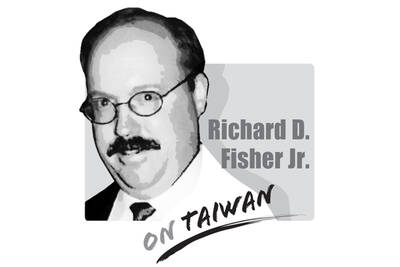Road signs can take us to places we would never have imagined.
The Ministry of the Interior is researching renaming roads — spelled variously as Zhongzheng (中正) in Taipei and Jhongjheng in other parts of the nation — named after former president Chiang Kai-shek (蔣介石). The difference in spelling itself has an ideological basis.
It is the name that adorns the Chiang Kai-shek Memorial Hall (中正紀念堂) in Taipei — the monument to the former dictator is spelled Chiang Kai-shek in English, but uses Zhongzheng in Chinese.
According to a study by the Transitional Justice Commission, 316 roads are named Zhongzheng or Jhongjheng; another 28 are named Jieshou (介壽), an abbreviation of the slogan “long live Chiang Kai-shek”; and 11 are named Jingguo (經國) after Chiang’s son and successor Chiang Ching-kuo (蔣經國).
Chiang Kai-shek chose Zhongzheng, which implies the qualities of uprightness, rectitude and orthodoxy, for himself. The name, glorifying the former dictator, is all around us.
All street names in Taiwan honoring Japanese or the state of Japan were changed in 1945 after the Chinese Nationalist Party (KMT) government assumed control of the former Japanese colony. Just as the Japanese had created names to glorify their colonial rule, so the KMT sought to erase this memory and establish a national narrative of its own.
Criticism about the plan to change the names centers on the projected cost of the endeavor. It is not about money. It is about ideology. Words and names matter. They frame collective memory and consciousness, they shape understanding. The degree to which this affects our cognitive understanding of our world depends on how wide we draw the circle, or how far we step back to observe, from the local to the international.
On this page, Yu Ming (嶼明) writes about the Chinese Communist Party’s (CCP) “discursive engineering,” the selective creation and use of names and terms to form its preferred narrative, and to change perceptions of history and truth regarding Taiwan.
On the local implications, Yu uses the example of a speech by Zhang Weiwei (張維為), a professor in China about how Taiwanese, and especially the younger generation, could be easily controlled through the targeted use of discursive engineering channeled through social media and short-video apps. Zhang said that this could “pave the way to eventual unification.”
The Taipei Times dealt with concerns over penetration of the Taiwanese consciousness through these apps in an editorial (“Use Chinese apps with care,” May 30, page 8), but the problem goes so much deeper.
The ministry has said that the reason for changing the road names is to emerge from the authoritarian past and to promote Taiwan’s local languages and culture, including those of indigenous communities. It is a way of returning the nation and, to use Yu’s phrase, “the boundaries of sovereign thought,” from the KMT regime to Taiwanese in the modern, democratic era.
Drawing the circle much wider to the international level, look at the words of Chinese President Xi Jinping (習近平) delivered in Moscow on May 7 in a speech entitled “Learning from History to Build Together a Brighter Future” to mark the end of World War II. Even within that context in a short speech, Xi devoted an entire paragraph on the “restoration” of Taiwan, citing the Cairo Declaration, the Potsdam Proclamation and UN Resolution 2758 as having “affirmed China’s sovereignty” over “the Taiwan island” and how they “legitimize” its “inevitable reunification.”
Multiple levels of vigilance against attempts to shape the narrative and collective thought are required. It starts in our own backyard, and with an awareness of the importance of names.

On Sept. 3 in Tiananmen Square, the Chinese Communist Party (CCP) and the People’s Liberation Army (PLA) rolled out a parade of new weapons in PLA service that threaten Taiwan — some of that Taiwan is addressing with added and new military investments and some of which it cannot, having to rely on the initiative of allies like the United States. The CCP’s goal of replacing US leadership on the global stage was advanced by the military parade, but also by China hosting in Tianjin an August 31-Sept. 1 summit of the Shanghai Cooperation Organization (SCO), which since 2001 has specialized
In an article published by the Harvard Kennedy School, renowned historian of modern China Rana Mitter used a structured question-and-answer format to deepen the understanding of the relationship between Taiwan and China. Mitter highlights the differences between the repressive and authoritarian People’s Republic of China and the vibrant democracy that exists in Taiwan, saying that Taiwan and China “have had an interconnected relationship that has been both close and contentious at times.” However, his description of the history — before and after 1945 — contains significant flaws. First, he writes that “Taiwan was always broadly regarded by the imperial dynasties of
The Chinese Communist Party (CCP) will stop at nothing to weaken Taiwan’s sovereignty, going as far as to create complete falsehoods. That the People’s Republic of China (PRC) has never ruled Taiwan is an objective fact. To refute this, Beijing has tried to assert “jurisdiction” over Taiwan, pointing to its military exercises around the nation as “proof.” That is an outright lie: If the PRC had jurisdiction over Taiwan, it could simply have issued decrees. Instead, it needs to perform a show of force around the nation to demonstrate its fantasy. Its actions prove the exact opposite of its assertions. A
A large part of the discourse about Taiwan as a sovereign, independent nation has centered on conventions of international law and international agreements between outside powers — such as between the US, UK, Russia, the Republic of China (ROC) and Japan at the end of World War II, and between the US and the People’s Republic of China (PRC) since recognition of the PRC as the sole representative of China at the UN. Internationally, the narrative on the PRC and Taiwan has changed considerably since the days of the first term of former president Chen Shui-bian (陳水扁) of the Democratic